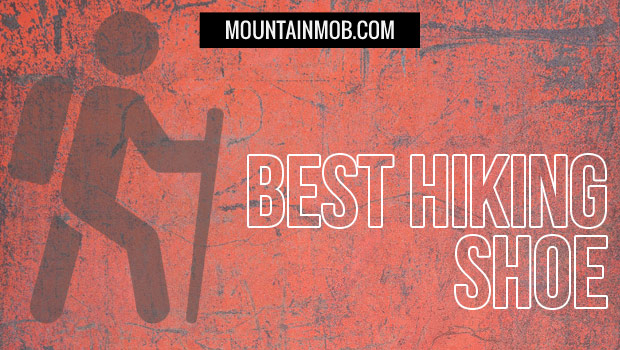Hiking
Best Hiking Shoe
First determine what type of hiking shoe you need:
When in the market for the best hiking boot, the first order of business is to determine what type of hiking you intend to use do.
For example, for light-duty hiking, a hiking shoe might be in order. Hiking shoes are usually low-cut with flexible midsoles and relatively light weight. These shoes are ideal for day hikers who don’t plan on carrying much of a load with them, and trail runners who plan on running long distances and need a little more support than that offered by an ordinary tennis shoe.
Hiking boots are what you might call a step up in performance when it comes to hiking footwear. They are usually mid- to high-cut and are designed to accommodate both day hikers and weekend backpackers who can be expected to carry slightly more accompaniments than the trail runner.
The hiking boot is still relatively flexible and doesn’t require that much breaking in, but they won’t provide enough support and durability required for more demanding adventures.
If you’re planning to go off-trail for your next hiking excursion, you might want to move up to the next ring on the totem pole in hiking boots: backpacking boots. Backpacking boots are made extra tough and durable enough to withstand a hiker carrying heavy loads for trips lasting several days. Most of them will have the distinctive, high-cut tops that wrap above the ankles to deliver maximum support, an absolute necessity for negotiating rugged, off-road terrain.
In addition to the durability and support they offer, they have stiffer midsoles than footwear designed for lesser jobs, yet they can be used for both on- and off-trail adventures.
The highest level you can go as far as hiking boots are concerned is mountaineering boots. As you would expect, these boots are heavier and stiffer than any of the previously-mentioned hiking boots. The additional weight and support is necessary for bearing the heavier loads a mountain climber can be expected to carry.
In addition, mountaineering boots adaptable to crampons to facilitate glacier travel.
Pay attention to the material used in your hiking shoe:
Once you’ve determined what type of hiking boot you’ll need, the next thing you’ll want to look at is the material used in the construction of the shoe. The materials the hiking boot is made from are especially important since they have a bearing on things like weight, breathability, durability and waterproofing.
The materials the hiking boot is made from are especially important since they have a bearing on things like weight, breathability, durability and waterproofing.
Full-grain leather. When it comes to uppers, full-grain leather is the choice for backpackers who plan to be on the trail for several days. It is durable and resists scuffing while its water repelling capabilities are excellent. However, you might want to take some time to break it in before going on a long trip.
Nylon/nylon mesh. To reduce weight, some models combine the durability of split-grain leather with the lightweight and breathable comfort of nylon or nylon mesh. With split-grain leather, the rough inside of the cow hide is stripped away, leaving the smooth exterior to be bonded with the nylon. The result is a lightweight, lower-cost hiking boot. However, the tradeoff is less water resistance and susceptibility to scuffing.
Waterproof. Of course, you can always opt for hiking boots that are totally waterproof. They use a waterproofing membrane to repel moisture, but, again, there is a trade-off: breathability is significantly reduced in waterproof boots.
Nubuck leather. Nubuck Leather is full grain leather that looks like suede. It is also very durable and resistant to water and scuffing. Plus it is very flexible, but it requires significant break-in time before taking it on an extended hike.
Synthetics. Some manufacturers have solved the break-in time problem by using synthetics in the construction of their hiking boots. Synthetics like polyester and nylon are common in today’s hiking boots. They are light and require very little break-in time. The downside is that they are not as durable as boots made from leather.
A hiking boot’s midsole is the part of the boot that absorbs the shock incurred when walking on rough terrain and is the main ingredient that determines the boot’s stiffness.
Referring to a boot as “Stiff” might not sound all that comfortable. If you’re out on a long hike on rocky and uneven terrain, you’ll need that extra stiffness for support and stability. Knowing this, you can determine the degree of stiffness you desire in a hiking boot.
Most midsoles are made of EVA (ethyl vinyl acetate) or polyurethane. These materials soften the blow delivered by walking on rough surfaces and prevent the foot from sharp objects like rocks instead of wrapping around them.
The predominant material for outsoles is, of course, rubber. But sometimes other ingredients, like carbon, are added to the rubber to increase hardness, like in backpacking and mountaineering boots. Increasing the hardness of the outsoles makes the boot last longer, but can also make them feel slippery when worn off-trail.
7 of the Best Hiking Shoes You Can Find:
Timberland White Ledge Waterproof Mid Boot
One name that has become synonymous with boots is Timberland and a perfect example of why they deserve the reputation they have can be seen in the Timberland White Ledge Waterproof Boot. This shoe has the leather/synthetic combination upper, so you know it is lightweight. It is fully waterproofed and has an EVA foam-cushioned footbed.
Merrell Moab Ventilator Mid Hiking Boot
The Merrell Men’s Moab Ventilator Mid Hiking Boot is another light hiking boot. It has a leather and mesh combo upper for lightweight and breathability. It also has a mid-height cut for just the right amount of support for light hiking.
Lowa Renegade GTX Mid Hiking Boot Mens/Womens
Lowa’s most popular boot, the Renegade, sports a new Monowrap Evo comfort construction for an even lighter, sleeker profile with a more supportive stabilizer. The slightly stiffer nylon shank provides enhanced performance for hikers who tackle more rugged terrain.
Salomon Comet 3D GTX Hiking Boots
Salomon Comets! Lightweight, durable ,waterproof and they look super cool as well!These boots are built to take anything you can throw at them from a hunting trip to a week or 2 on the Appalachian trail, or they look great just for casually wearing around town – See more at:
[su_spacer size=”60″]asdf[/su_spacer]KEEN Men’s Targhee II Hiking Shoe
Available in shoe and boot styles, Keen Men’s Targhee II is the ideal hiking partner. The rugged Targhee II gives you the comfort and support of an athletic shoe and the resilience and protective features of a rough-and-tough hiking boot. This style keeps your feet dry and your step steady thanks to a waterproof nubuck upper, 4-millimeter multi-directional lugs, and a Keen.Dry, waterproof membrane. And for exceptional support mile after mile, the Targhee II combines an S3 heel structure with a dual-density, compression-molded EVA midsole and a Keen Metatomical EVA footbed.
Asolo Power Matic 200 GV
The Asolo Power Matic 200 GV Men’s Boot boasts a water-resistant full grain single leather (ranging from 2, 6-2, 8 mm thickness) upper, Gore-Tex lining for complete waterproofness, and a technical sole. The sole consists of an Asolo/Vibram rubber bottom and a triple-density PU midsole.




